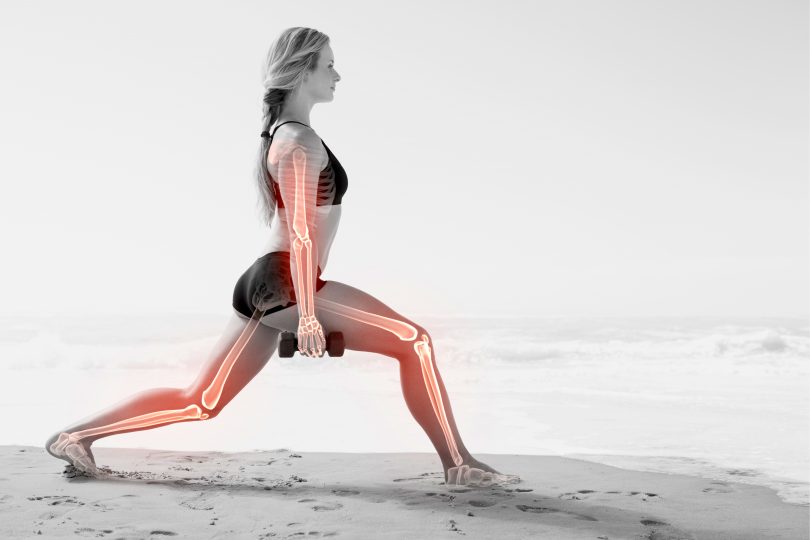If you grew up in the 80s or 90s in the U.S., you likely remember all the “Got milk?” commercials centered around getting enough calcium and vitamin D in our diets.
I was a kid back then so all I really paid attention to was the images of celebrities that I knew adorning white milk mustaches, but the true focus of the campaign was bone health. Since then, cow’s milk has grown a bit controversial about whether or not it’s even helpful, the message still remains that diet is one of the most important factors in overall bone health.
But calcium alone won’t put you in the clear. Things like physical exercise, tobacco, alcohol, and drug use, eating disorders, certain medications, hormone levels, and even race, age and gender all contribute to overall bone health and the likelihood of developing certain disorders. For example, bone loss is more prevalent in Asian and Caucasian women and can be exacerbated by steroids.
As it turns it, cannabis might also have a place in this list of things that can affect our bones. But what are the implications of this? Can cannabinoids help restore bone health and prevent or delay the onset of bone disease?
What is Osteoporosis?
Let’s start with the most common bone disease, Osteoporosis, which literally means porous bone. It’s a disorder characterized by decreased bone density that leads to reduced bone strength and increased risk of sprains and fractures. It’s estimated that more than 200 million people are currently suffering from osteoporosis.
Before developing into Osteoporosis, the patient will have a condition known as osteopenia – a disorder where the bone is only slightly less dense than regular bone. Often times, there are no symptoms indicating the presence of osteopenia or even osteoporosis. Many patients are first diagnosed when a simple, everyday task results in an unexpected fracture.
There are two types of fractures: “cracking”, like with a fractured hip, or “collapsing”, like in the case of a spinal or vertebral compression fracture. A break can occur in just about any bone in the body, but the most susceptible areas are your hips, ribs, spine, ankles, and wrists.
Osteoporosis has numerous causes – many of which are lifestyle related – but the most common triggers are due to hormonal issues such as low estrogen, low testosterone, and other age-related imbalances.

Cannabis and Osteoporosis
A 2016 headline that got a lot of attention was titled “Heavy marijuana use linked to 5 percent reduction in bone density”. For their study, the research team analyzed the data of 284 adults who attended primary care centers in the U.K. between 2011-2013; and the results are self-explanatory.
However, other research indicates that cannabidiol (CBD) can help prevent bone disease, hinder degeneration, and accelerate healing. A study published in the American Society for Bone and Mineral Research shows that cannabis treatment helps control osteoporosis by way of the Endocannabinoid System (ECS), which plays a pivotal role in developing, strengthening, and preserving the bones.
During the study, researchers injected either a combination of CBD with THC (tetrahydrocannabinol), or just isolated CBD, into rats with broken thigh bones. While the THC mixture did help relieve pain related to bone injuries and fractures, it was not very effective in actually healing the bone itself or speeding up the rate of recovery. On the other hand, CBD had quite an impact, not at making the bone heal quicker, but at strengthening it to prevent a future break.
According to the results, the bone treated with CBD was up to 50% stronger than the non-treated bones.
What is Osteogenesis Imperfecta
Osteogenesis Imperfecta is a congenital disease (meaning it’s present at birth) that causes extremely fragile bones. It’s commonly referred to as brittle bone disease and it’s caused by a defect in the gene that produces type 1 collagen – an important building block of bones. There are multiple different variations that can affect this gene.

The severity of OI depends on the specific gene in question. As of now there are 8 known types of OI and the severity is as follows: Type 1 is mild, types 4, 5, 6, and 7 are moderate, and the most severe are types 2, 3, and 8. Most cases of OI are inherited from one parent, although in rare circumstances they can be the result of a new genetic mutation . OI is in autosomal dominant disease and there is a 50% chance of parents passing the genetic mutation, and thus the disease, on to their children.
There is no cure for this disease, but certain therapies and medications can reduce pain and complications associated with OI. Commonly used drugs are biophosphonates which have been successfully used to treat osteoporosis. Further intervention can include physical therapy and surgically inserted metal rods that can be used to artificially improve bone strength and reduce the risk of fractures.
Cannabis and Osteogenesis Imperfecta
As of now, there is no official research on the effects of cannabinoid medication and OI. However, there are multiple studies looking at the impact that cannabinoids have on bone cell formation and function, which indicates that it could be a viable, future option in treating this disorder. OI is a qualifying condition for a medical cannabis card in only one state so far, Connecticut. Disorders of the bones are not yet frequently discussed in the medical cannabis community.
In 2007, researchers at the University of Sheffield in UK discovered that “cannabinoids may stimulate the recruitment of mesenchymal stem cells (MSCs) from the bone marrow indirectly via an accessory cell and mediated via the CB(2) receptor.” This mechanism is believed to be responsible for increased bone formation following cannabinoid treatment “in vivo”.
Another study, titled ‘Cannabinoids and bone: endocannabinoids modulate human osteoclast function in vitro’, found that low concentrations of CBD and CBG (cannabigerol) can activate human osteoclasts “in vitro”. According to the study, “There is a dynamic regulation of the expression of the CB(2) receptor and the production of the endocannabinoids during the differentiation of human bone cells. These data suggest that small molecules modulating the endocannabinoid system could be important therapeutics in human bone disease.”
Final Thoughts on Cannabis and Bones
Although it’s still a bit unconventional, it seems that cannabis has great potential as possible future therapy for those suffering from diseases of the bones. More research is needed on this topic to determine the full capacity of what cannabinoids can do for these patients, but for the time being, it can be used to relieve secondary symptoms caused by osteoporosis or osteogenesis imperfecta, such as pain cause by a fracture or anxiety relating to the disorder.
***These statements have not been evaluated by the Food and Drug Administration. The efficacy of these products and the testimonials made have not been confirmed by FDA- approved research.
This article is not intended to diagnose, treat, cure or prevent any disease or ailment. All information presented here is not meant as a substitute for or alternative to information from health care practitioners.
Please consult with a trusted healthcare professional about potential interactions or other possible complications before using any cannabis or CBD product.
References:
“Heavy Cannabis Use Is Associated With Low Bone Mineral Density and an Increased Risk of Fractures.” The American Journal of Medicine. Feb 2017. Volume 130(2):214–221
“Cannabidiol, a Major Non‐Psychotropic Cannabis Constituent Enhances Fracture Healing and Stimulates Lysyl Hydroxylase Activity in Osteoblasts.” 2016 Oct. The American Society for Bone and Mineral Research. March 2015. Volume 30(10):1905-1913
“Cannabinoids stimulate fibroblastic colony formation by bone marrow cells indirectly via CB2 receptors.” Calcified Tissue International. Jan 2007, Volume 80(1):50-59
“Cannabinoids and bone: endocannabinoids modulate human osteoclast function in vitro.” British Journal of Pharmacology. Apr 2012. Volume 165(8):2584-2597








Thank you so much x
Yes THC does work especially well with Osteogenesis Imperfecta and it should be taken as seriously as any other medication given to people who have this disease. It relaxes muscles, joints and ligaments, helps with fatigue and helps with anxiety. It relieves the pain right away 🙂 And there is no bad side effect, compared to other medications 😉